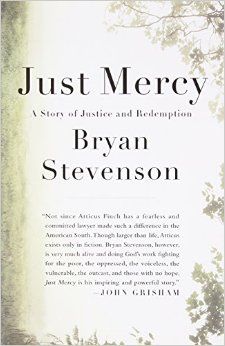“Just Mercy”
By: Bryan Stevenson
Grade: A+
Imagine this: you’re a lawyer representing a black man in Alabama, and you’re walking into a courthouse with a Confederate flag glaring at you from a flagpole. Recent news may have you questioning this image, but Bryan Stevenson is 30 years ahead of you.
Stevenson, who published his memoir, “Just Mercy,” in 2014, has been a lawyer for 30 years. He’s famous for founding the Equal Justice Initiative, a nonprofit organization dedicated to upholding social justice and defending human rights. He has spoken before the Supreme Court five times and received several awards and recommendations for his work for human rights.
The book is structured around the true story of Walter McMillian, a black man from Alabama who was convicted of a grisly murder in his hometown in 1988. Although Walter is innocent, he’s a suspect because of his secret affair with a white woman.The evidence against Walter is nonsensical, the prosecution near laughable and the judge — whose name is Robert E. Lee Key Jr., not kidding — openly racist. These and a host of other factors lead Walter, an insistently innocent man, to death row. The book follows Stevenson as he represents Walter through the lengthy exoneration process and the aftermath.
The rest of the book is paced with extreme court cases that highlight the problems with America’s judicial system. For example, a child defends his mother from an abusive boyfriend in the case of a minor named Charlie,and an addled war vet is convicted for placing a bomb on his ex’s porch in order to win her back — still not kidding — in Richardson v. Thigpen. All the while, Stevenson points to critiques of the judicial system, specifically of the way courts try children as adults and throw disabled people in prison instead of more appropriate facilities.
Stevenson frequently uses statistics to make a point, and the numbers speak for themselves. He writes that in 2001, one in every 15 people born in the United States was expected to go to jail or prison, adding that a quarter million kids go to adult jails and prisons to serve long prison terms. He opens the book with these statistics, preparing you for the rest. The book is heavily researched and sourced with individual cases and independent studies, leaving little doubt that these numbers are accurate.
Most of the cases described happened more than20 years ago, but because of the way Stevenson presents them, you would hardly realize that. In his descriptions, they could have happened yesterday, had certain laws not been put in place. Take the case of David Nelson, a drug addict on death row with compromised veins that made administering the drugs difficult. When the time for his execution came, the medically untrained staff planned to make an incision without anesthesia. Stevenson brought this case before the Supreme Court in 2004, which in turn propelled our nation’s current dilemma over lethal injection.
Despite his hand in this progress and the fact that some believe him to be “America’s NelsonMandela,” there’s never an overwhelming feeling that Stevenson is praising himself. On the contrary, the chapters not involving the McMillian case seem almost detached. Stevenson instead uses his memoir to focus on the people he has met with and represented, letting their stories speak for him. At the beginning of the book, he introduces himself as a young college student who still isn’t sure what he wants to do with his life. This same student meets his first death row inmate in an interaction that grabs both the reader and the author. This is the turning point that decided Stevenson’s career as a lawyer — as guards took the inmate back to his cell, he sings because Stevenson agreed to represent him.
A fair warning: this microscope into the prison system is not for the faint of heart. Many of the chapters include devastating stories about incarcerated children, women and mentally ill people.He also brings up the atrocities that supposed rehabilitators commit in prisons, especially in women’s prisons, where guards sometimes assault and rape inmates, getting them pregnant. Stevenson uses most of the excerpts to illustrate broader points about how far the judicial system hascome in terms of racial discrimination and unfair sentencing.
Throughout the book, Stevenson seems intensely hopeful as he represents inmates sentenced to death.He writes, “Each of us is more than the worst thing we’ve ever done.” The book succeeds in reminding that our judicial system is human— or, imperfect. His hope comes through his aim to show the public that humanity —or, forgiveness and understanding — can also fix the system.
Some lines feel clunky, such as a lengthy description of guards trying get an inmate in a wheelchair unstuck from inside a small cage. These likely remain due to Stevenson’s dedication to the facts of each story. He confidently sets up each story, beginning each excerpt by setting up a — for the most part — innocent or misunderstood individual. By writing the stories from the beginning and acquiring all the details instead of starting with their outcomes, Stevenson leads readers to cheer or cringe as each new case unfolds.
“Just Mercy” is a timely collection of stories covering themes from wrongful incarceration to racial injustice and everything in between. If you’ve ever questioned the scales of justice in the deep south, Bryan Stevenson has the answer for you.



